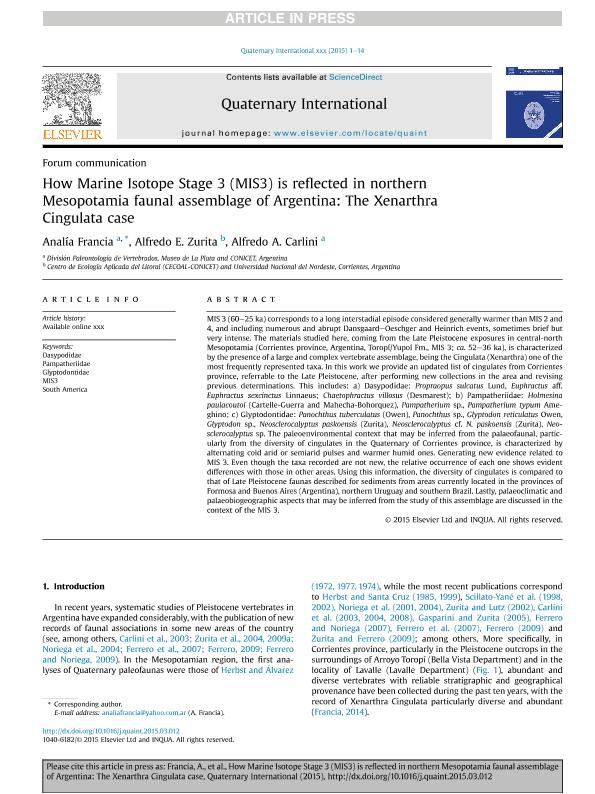Artículo
How Marine Isotope Stage 3 (MIS3) is reflected in northern Mesopotamia faunal assemblage of Argentina: The Xenarthra Cingulata case
Fecha de publicación:
04/2015
Editorial:
Pergamon-Elsevier Science Ltd
Revista:
Quaternary International
ISSN:
1040-6182
Idioma:
Inglés
Tipo de recurso:
Artículo publicado
Clasificación temática:
Resumen
MIS 3 (60-25 ka) corresponds to a long interstadial episode considered generally warmer than MIS 2 and 4, and including numerous and abrupt Dansgaard-Oeschger and Heinrich events, sometimes brief but very intense. The materials studied here, coming from the Late Pleistocene exposures in central-north Mesopotamia (Corrientes province, Argentina, Toropí/Yupoí Fm., MIS 3; ca. 52-36 ka), is characterized by the presence of a large and complex vertebrate assemblage, being the Cingulata (Xenarthra) one of the most frequently represented taxa. In this work we provide an updated list of cingulates from Corrientes province, referrable to the Late Pleistocene, after performing new collections in the area and revising previous determinations. This includes: a) Dasypodidae: Propraopus sulcatus Lund, Euphractus aff. Euphractus sexcinctus Linnaeus; Chaetophractus villosus (Desmarest); b) Pampatheriidae: Holmesina paulacoutoi (Cartelle-Guerra and Mahecha-Bohorquez), Pampatherium sp., Pampatherium typum Ameghino; c) Glyptodontidae: Panochthus tuberculatus (Owen), Panochthus sp., Glyptodon reticulatus Owen, Glyptodon sp., Neosclerocalyptus paskoensis (Zurita), Neosclerocalyptus cf. N. paskoensis (Zurita), Neosclerocalyptus sp. The paleoenvironmental context that may be inferred from the palaeofaunal, particularly from the diversity of cingulates in the Quaternary of Corrientes province, is characterized by alternating cold arid or semiarid pulses and warmer humid ones. Generating new evidence related to MIS 3. Even though the taxa recorded are not new, the relative occurrence of each one shows evident differences with those in other areas. Using this information, the diversity of cingulates is compared to that of Late Pleistocene faunas described for sediments from areas currently located in the provinces of Formosa and Buenos Aires (Argentina), northern Uruguay and southern Brazil. Lastly, palaeoclimatic and palaeobiogeographic aspects that may be inferred from the study of this assemblage are discussed in the context of the MIS 3.
Palabras clave:
Dasypodidae
,
Glyptodontidae
,
Mis3
,
Pampatheriidae
,
South America
Archivos asociados
Licencia
Identificadores
Colecciones
Articulos(CCT - LA PLATA)
Articulos de CTRO.CIENTIFICO TECNOL.CONICET - LA PLATA
Articulos de CTRO.CIENTIFICO TECNOL.CONICET - LA PLATA
Citación
Francia, Analia; Zurita, Alfredo Eduardo; Carlini, Alfredo Armando; How Marine Isotope Stage 3 (MIS3) is reflected in northern Mesopotamia faunal assemblage of Argentina: The Xenarthra Cingulata case; Pergamon-Elsevier Science Ltd; Quaternary International; 377; 4-2015; 126-139
Compartir
Altmétricas




